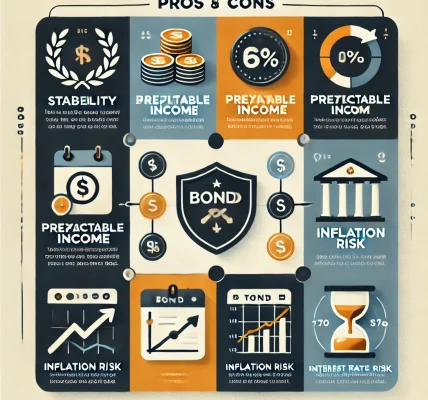Introduction
In an uncertain economic climate, maintaining a defensive investment strategy is essential for preserving wealth and ensuring consistent returns. Treasury bonds, often considered the safest fixed-income instruments, play a crucial role in stabilizing portfolios during volatile market conditions. Their low-risk profile, predictable income, and government backing make them a cornerstone of defensive investment strategies.
In this detailed guide, we’ll explore how Treasury bonds can safeguard your investments, analyze their advantages and disadvantages, and provide actionable strategies to incorporate them effectively into your portfolio.
🎯 What Are Treasury Bonds?
Treasury bonds (T-bonds) are long-term debt securities issued by the U.S. Department of the Treasury to finance government spending. They have maturities ranging from 10 to 30 years and pay fixed interest semi-annually until maturity, at which point the principal amount is returned to the investor.
✅ Key Features of Treasury Bonds:
- Government-Backed Security: Virtually risk-free, as they are backed by the U.S. government.
- Fixed Interest Payments: Predictable income through semi-annual coupon payments.
- Tax Advantages: Exempt from state and local taxes, but subject to federal taxes.
📊 Why Include Treasury Bonds in a Defensive Investment Strategy?
A defensive investment strategy focuses on minimizing risk and preserving capital, making Treasury bonds an ideal fit due to their stability and predictable returns.
✅ Key Reasons to Include Treasury Bonds:
- 📉 Capital Preservation: Safeguard against market volatility.
- 💸 Reliable Income Stream: Regular interest payments ensure a consistent cash flow.
- 🛡️ Hedge Against Economic Downturns: Treasury bonds outperform equities during economic recessions.
🛡️ 5 Key Benefits of Treasury Bonds in a Defensive Portfolio
✅ 1. Capital Preservation and Safety
Treasury bonds offer guaranteed repayment of principal upon maturity, making them a safe haven asset in times of economic uncertainty.
✅ Why It Matters:
- Reduces exposure to market volatility.
- Protects wealth during recessions or geopolitical instability.
✅ 2. Stable and Predictable Income
T-bonds provide fixed interest payments every six months, ensuring a reliable income stream regardless of market conditions.
✅ Why It Matters:
- Ideal for retirees and conservative investors seeking consistent returns.
- Protects against unpredictable stock market fluctuations.
✅ 3. Low Correlation with Equities
Treasury bonds have a low or negative correlation with stocks, meaning their prices often move in the opposite direction of the stock market.
✅ Why It Matters:
- Diversification benefit to balance risk in a portfolio.
- Reduces overall portfolio volatility.
✅ 4. Effective Hedge Against Deflation
During periods of deflation or economic slowdown, Treasury bonds increase in value, offering a hedge against falling prices.
✅ Why It Matters:
- Protects purchasing power when inflation is low or negative.
- Provides a safe store of value during economic downturns.
✅ 5. Tax Efficiency
Interest earned on Treasury bonds is exempt from state and local taxes, which enhances their tax efficiency for high-net-worth individuals.
✅ Why It Matters:
- Reduces overall tax burden, increasing after-tax returns.
- Ideal for investors in high-tax states.
📈 Types of Treasury Securities to Include in a Defensive Portfolio
🕰️ 1. Treasury Bonds (T-Bonds)
- Maturity: 10 to 30 years
- Suitable for long-term capital preservation and income.
✅ Best For:
- Investors seeking consistent income over long durations.
📉 2. Treasury Notes (T-Notes)
- Maturity: 2 to 10 years
- Balances moderate yield with relatively low interest rate risk.
✅ Best For:
- Investors looking for medium-term stability.
📊 3. Treasury Bills (T-Bills)
- Maturity: Less than 1 year
- Zero-coupon instruments sold at a discount and redeemed at face value.
✅ Best For:
- Short-term liquidity and safety.
💡 4. Treasury Inflation-Protected Securities (TIPS)
- Maturity: 5, 10, or 30 years
- Principal and interest payments adjust with inflation to protect purchasing power.
✅ Best For:
- Hedging against inflation and preserving real returns.
⚖️ Comparing Treasury Bonds with Other Defensive Assets
| Feature | Treasury Bonds | Municipal Bonds | Corporate Bonds |
|---|---|---|---|
| Safety Level | Highest | Moderate | Lower |
| Interest Payments | Fixed and Semi-Annual | Fixed and Tax-Free | Higher but Riskier |
| Maturity Range | 10 to 30 years | 1 to 30 years | 1 to 30 years |
| Tax Benefits | Exempt from State Taxes | Federally Tax-Exempt | Fully Taxable |
| Suitability for Defensive Portfolios | Excellent | Good | Moderate |
🎯 How to Incorporate Treasury Bonds into a Defensive Investment Strategy
✅ 1. Diversify Across Maturities with a Bond Ladder
A bond ladder involves purchasing Treasury bonds with staggered maturities to create a consistent income stream and reduce reinvestment risk.
✅ How It Works:
- Purchase Treasury bonds with varying maturities (e.g., 5, 10, and 20 years).
- As bonds mature, reinvest the proceeds into new bonds.
✅ 2. Balance Duration and Yield with T-Notes and TIPS
To balance duration and yield, combine Treasury notes (T-Notes) for medium-term income with TIPS to protect against inflation.
✅ Why It Works:
- Provides stability in the short and medium term.
- Ensures real returns in inflationary environments.
✅ 3. Allocate a Percentage of the Portfolio to Treasury Bonds
A well-balanced defensive portfolio should allocate 20-40% to Treasury bonds depending on risk tolerance and investment goals.
✅ Suggested Allocation:
- Conservative Investors: 40% in Treasury bonds.
- Moderate Investors: 20-30% in Treasury bonds.
✅ 4. Use Treasury Bonds as a Safety Net During Volatility
During periods of market turmoil, shift a higher portion of assets to Treasury bonds to reduce overall portfolio risk.
✅ Why It Works:
- Protects against downside risks.
- Ensures capital preservation during market downturns.
📚 Case Study: Building a Defensive Portfolio with Treasury Bonds
Scenario:
- Investor A is a 55-year-old retiree seeking capital preservation and regular income.
- Market volatility and inflation concerns necessitate a defensive investment strategy.
✅ Portfolio Allocation:
- 40% Treasury Bonds for long-term stability.
- 20% TIPS to protect against inflation.
- 20% Corporate Bonds for moderate returns.
- 10% Treasury Bills for short-term liquidity.
- 10% Equity Exposure for growth potential.
⚡ Potential Risks and Mitigation Strategies
⚠️ 1. Interest Rate Risk
Rising interest rates may reduce the market value of existing bonds.
✅ Mitigation:
- Invest in a bond ladder to stagger maturities and reduce exposure.
⚠️ 2. Inflation Risk
Fixed-income bonds may lose purchasing power in inflationary environments.
✅ Mitigation:
- Include TIPS in the portfolio to offset inflation effects.
⚠️ 3. Reinvestment Risk
Falling interest rates may lead to lower returns on reinvested proceeds.
✅ Mitigation:
- Diversify maturities and maintain a balanced portfolio.
🎉 Conclusion: Strengthen Your Defensive Investment Strategy with Treasury Bonds
Incorporating Treasury bonds into a defensive investment strategy offers unparalleled safety, predictable returns, and protection against market volatility. By diversifying across maturities, balancing duration, and incorporating inflation-protected securities, investors can safeguard their portfolios from economic uncertainty and ensure consistent long-term growth.
By leveraging the stability and reliability of Treasury bonds, investors can create a resilient portfolio that thrives in any market condition.




